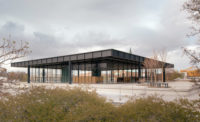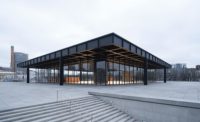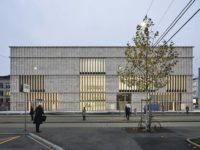David Chipperfield Architects Berlin Completes Second Phase of Neue Nationalgalerie Renovation

The renovated Neue Nationalgalerie
Photo courtesy David Chipperfield Architects Berlin

Historic photograph of the Neue Nationalgalerie
Photo courtesy David Chipperfield Architects Berlin

The renovated Neue Nationalgalerie
Photo courtesy David Chipperfield Architects Berlin

Inside the renovated Neue Nationalgalerie
Photo courtesy David Chipperfield Architects Berlin




Architects & Firms
Last month, the Neue Nationalgalerie by Ludwig Mies van der Rohe marked two major milestones: the fiftieth anniversary of its inauguration on September 15, 1968, and the end of the second phase of an ongoing renovation by David Chipperfield Architects Berlin.
The firm won the commission to restore the historic monument in 2012 and spent four years devising a scheme to preserve the museum’s open plan, glass-enclosed, above-ground space and below-grade galleries, while improving visitor access, optimizing museum operations, and addressing technical issues. Dirk Lohan of Chicago, the original project architect and Mies van der Rohe’s grandson, and Fritz Neumeyer, Berlin, a Mies scholar, serve as consultants on the renovation.
Construction on the first phase began in 2016. Workers dismantled, catalogued, refurbished and stored an estimated 35,000 building parts and removed of harmful materials, leaving the black steel frame and the reinforced concrete substructure stripped bare.
During phase two, which started last year, crews restored the reinforced concrete substructure and walls enclosing the outdoor sculpture garden; inserted a second elevator; and replaced a steep ramp on the eastern terrace with a new, gentler slope.
Below grade, the project restores Mies’ public circulation scheme and upgrades visitor service amenities such as the café and cloakroom. The most extensive modification is the excavation below the eastern terrace, which will create an additional 9,700 square feet for storage and technical spaces.
For the final phase, the dismantled building components will be reinstalled, along with new heating, air circulation, lighting and electrical systems. The exterior steel will be sandblasted and given a coat of the original Detroit graphite black paint.
Construction is scheduled to end in 2019, and the Neue Nationalgalerie is slated to reopen in 2020. The goal is not a new interpretation, but rather as faithful a renovation as possible. The subtle changes—including improved access and the carefully restored details, surfaces, and structure—promise to heighten an appreciation for the building’s enduring values. “You could say that our work here is really boring,” says David Chipperfield. “We remain old-fashioned, how things are made and how they feel are lasting qualities of architecture.”








